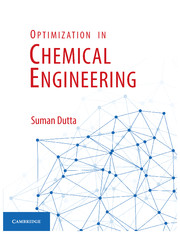Book contents
- Frontmatter
- Dedication
- Contents
- List of Figures
- List of Tables
- Preface
- 1 A Brief Discussion on Optimization
- 2 Formulation of Optimization Problems in Chemical and Biochemical Engineering
- 3 Single Variable Unconstrained Optimization Methods
- 4 Trust-Region Methods
- 5 Optimization of Unconstrained Multivariable Functions
- 6 Multivariable Optimization with Constraints
- 7 Optimization of Staged and Discrete Processes
- 8 Some Advanced Topics on Optimization
- 9 Nontraditional Optimization
- 10 Optimization of Various Chemical and Biochemical Processes
- 11 Statistical Optimization
- 12 Software Tools for Optimization Processes
- Multiple Choice Questions – 1
- Multiple Choice Questions – 2
- Multiple Choice Questions – 3
- Index
- References
11 - Statistical Optimization
Published online by Cambridge University Press: 05 February 2016
- Frontmatter
- Dedication
- Contents
- List of Figures
- List of Tables
- Preface
- 1 A Brief Discussion on Optimization
- 2 Formulation of Optimization Problems in Chemical and Biochemical Engineering
- 3 Single Variable Unconstrained Optimization Methods
- 4 Trust-Region Methods
- 5 Optimization of Unconstrained Multivariable Functions
- 6 Multivariable Optimization with Constraints
- 7 Optimization of Staged and Discrete Processes
- 8 Some Advanced Topics on Optimization
- 9 Nontraditional Optimization
- 10 Optimization of Various Chemical and Biochemical Processes
- 11 Statistical Optimization
- 12 Software Tools for Optimization Processes
- Multiple Choice Questions – 1
- Multiple Choice Questions – 2
- Multiple Choice Questions – 3
- Index
- References
Summary
Large number of experimental run is required to develop the input-output relationship of any process. Utilization of statistical methods can reduce the number of the experimental run. This chapter elucidates the design of experiment for optimize use of experimental data. Response surface methodology is used to optimize the process output. A process plant can be optimized efficiently using these methods.
Design of Experiment
A huge number of experiments are required in research, development and optimization of any system. This research is carried out in labs, pilot plants or full-scale plants. An experiment may be a model based experiment or experiment with the physical system [Lazić, (2004)]. When the experimentation cost is very high, it is very difficult for the researcher to examine the numerous factors that have an effect on the processes using trial and error methods within a short time and limited resources. As an alternative, we need a technique that identifies some key factors in the most effective way. Then this leads the process to the best setting to satisfy the increasing demand for increased productivity with improved quality.
A one-factor-at-a-time experiment is used to study the effect of various factors during experimentation. This method involves changing a single factor at a time to analyze the impact of that factor on the product or process output. The main advantage of “one-factor-at-a-time” experiment is that we can perform the experiment easily. Despite this fact, these methods do not permit us to investigate of how a factor influences the process or a product in the presence of other factors. When the response of a process is changed due to the existence of one or more other factors, that relationship is called an interaction. Sometimes the effects of interaction terms are more significant compared to the individual effects. Because in the application environment of the process or product, most of the factors present together rather than the isolated incidents of single factors at different times. A chemical reacting system can be considered as an example of interaction between two factors. The reaction rate slightly increases when the temperature is increased and there is no effect of pressure on reaction rate. However, the reaction rate changes rapidly when both the temperature and pressure are changing simultaneously. In this system, an interaction does exist between the two factors that affect the chemical reaction.
Information
- Type
- Chapter
- Information
- Optimization in Chemical Engineering , pp. 284 - 306Publisher: Cambridge University PressPrint publication year: 2016
